The Year of Reading Proust discussion

This topic is about
The Captive / The Fugitive
The Captive, vol. 5
>
Through Sunday, 13 Oct.: The Captive
 @Unregistered
@UnregisteredBut while she was speaking, and I thought once more
of Vinteuil, it was the other, the materialist hypothesis,
that of there being nothing, that in turn presented itself to
my mind. I began to doubt again; I told myself that after
all it might be the case that, if Vinteuil's phrases seemed
to be the expression of certain states of soul analogous to
that which I had experienced when I tasted the madeleine
soaked in tea, there was nothing to assure me that the
vagueness of such states was a sign of their profundity
rather than of our not having yet learned to analyze them,
so that there might be nothing more real in them than in
other states. And yet that happiness, that sense of certainty
in happiness while I was drinking the cup of tea, or
when I smelt in the Champs-Elysées a smell of moulder-
ing wood, was not an illusion. In any case, whispered the
spirit of doubt, even if these states are more profound
than others that occur in life, and defy analysis for that
very reason, because they bring into play too many forces
of which we have hitherto been unaware, the charm of
certain phrases of Vinteuil's music makes us think of
them because it too defies analysis, but this does not
prove that it has the same profundity; the beauty of a
phrase of pure music can easily appear to be the image of
or at least akin to an unintellectual impression which we
have received, but simply because it is unintellectual. And
why then do we suppose to be specially profound those
mysterious phrases which haunt certain quartets and this
septet by Vinteuil? ML p. 513-514
 Marcelita wrote: "Kalliope wrote: "Another pastel by De La Tour, different from the one Karpeles has included in his book...
Marcelita wrote: "Kalliope wrote: "Another pastel by De La Tour, different from the one Karpeles has included in his book...Son nez, sa bouche, ses yeux formaient une harmonie parfaite, isolée du reste, elle avait..."
I had not heard of this painter, Marcelita. Very interesting. Yes, there is something special about the open fan (what does it suggest?) while her face and glance is turned to the side...
 Kalliope wrote: "References to war, to the new kind of war, begin to creep in...
Kalliope wrote: "References to war, to the new kind of war, begin to creep in..... tout dépend de cette bataille. Mais ces batailles ressemblent moins à celles d'autrefois, qui duraient quelques heures, qu'à une..."
The references to a war continue in the following pages to the quote above..
Si cela doit fatalement arriver un jour ou l'autre, autant en finir tout de suite. Les préparatifs de guerre, que le plus faux des adages préconise pour faire triompher la volonté de paix, créent au contraire, d'abord la croyance chez chacun des deux adversaires que l'autre veut la rupture, et quand elle a eut lieu cette autre croyance chez chacun des deux que c'est l'autre qui l'a voulue.> p. 471.
and the image continues in next page...
Enfin il peut aussi arriver qu'un des deux adversaires soit réellement résolu à la guerre..
This is "game theory" but applied to war.
Gautier-Vignal speaks of how very interested was Proust in following the way the war was proceeding. That he had his room, and piano, full of newspapers and maps...
 Kalliope wrote: "On the dream that a trip to Venice, and the Fortuny designs, mean..., and Tiepolo's pink...
Kalliope wrote: "On the dream that a trip to Venice, and the Fortuny designs, mean..., and Tiepolo's pink...Et les manches étaient doublées d'un rose cerise qui est si particulièrement vénitien qu'on l'appelle ro..."
Thank you for leaving this link Kalliope. I'm glad I decided to google Tiepolo Pink because I found it relating to Proust.
"In the Art of the Tiepolo a Single Gesture Is Often Equivalent to a Long Sentence.This expression of semantic holism became an important notion in the eighteenth century and applies to the art of his contemporaries Giambattista and Domenico Tiepolo. Their powerful rhetoric constructs richly layered images often using a single symbol to import a variety of meanings—albeit frequently left to the viewer to interpret."
"It is present in symbols having double entendres, such as the snake, which could stand for both evil and salvation."
"The rosa of the title also imparts ambiguity. The color is associated with Proust's women, the soft tonality close to cherry in the dresses of Odette, the Countess of Guermantes, and Albertine. At first sight this color reference may appear as a "recherche" to—once more—accuse the eighteenth century of frivolity and decadence. However, the rosa is full of both possibilities and impossibilities. Proust's Madame Swann appears in a "marvelous dressing gown of crêpe de Chine or silk, antique rose, rose Tiepolo, white, mauve, green, red, yellow, plain or with motifs" (39). It is not just a single hue, but a polyphony of colors, ever changing—analogous to the migratory symbols in Tiepolo's art."
source: http://muse.jhu.edu/journals/ecs/summ...
 Kalliope wrote: "And the arabic manuscripts with birds...
Kalliope wrote: "And the arabic manuscripts with birds..."
I take it this is from the Conference of the
Birds?
http://www.metmuseum.org/toah/works-o...
 Kalliope wrote: "So, I found the birds.... In the introduction Jean Milly mentions a letter that Proust sent to Maria de Madrazo. She was Reynaldo Hahn's sister, and related to Fortuny through her marriage. Fort..."
Kalliope wrote: "So, I found the birds.... In the introduction Jean Milly mentions a letter that Proust sent to Maria de Madrazo. She was Reynaldo Hahn's sister, and related to Fortuny through her marriage. Fort..."I still haven't caught up to any part on the birds, so I'm a bit lost about where you're coming from with this mention of the birds. However, a little googling and I found this mention of the Guermantes as a race of birds and the role of the bird in Proust's writing.
http://www.jstor.org/discover/10.2307...
Edit: I found the section. I imagine that reading Proust was great advertisement for the Fortuny gowns, for which woman could resist the opportunity to wear one and be resurrected?! I can see the commercial for the Fortuny gown in my head!
 A great link that should be posted somewhere else in the archive:
A great link that should be posted somewhere else in the archive:http://heron.snell.clarkson.edu/~horn...
 ReemK10 (Paper Pills) wrote: "Kalliope wrote: "On the dream that a trip to Venice, and the Fortuny designs, mean..., and Tiepolo's pink...
ReemK10 (Paper Pills) wrote: "Kalliope wrote: "On the dream that a trip to Venice, and the Fortuny designs, mean..., and Tiepolo's pink...Et les manches étaient doublées d'un rose cerise qui est si particulièrement vénitien q..."
Reem,
This is wonderful. I have the book and I am very much looking forward to reading it. I enjoyed his The Marriage of Cadmus and Harmony and also have La Folie Baudelaire to read.
I love Tiepolo and visited not too long ago his frescoes in the residence in Würzburg. I have also read Tiepolo and the Pictorial Intelligence.
But I was not aware that Tiepolo Pink also discussed Proust.
Now I don't know which one I should tackle first, the Tiepolo or the Baudelaire books... Either one...
 ReemK10 (Paper Pills) wrote: "
ReemK10 (Paper Pills) wrote: "I take it this is from the Conference of the
Birds?
http://www.metmuseum.org/toah/works-o..."
Lovely, Reem.. Thank you.
 An overkill of my comments this morning, but here is one more interesting tid bit.
An overkill of my comments this morning, but here is one more interesting tid bit. "In the creation of the Sévigné pattern, Fortuny was repaying an artistic debt to novelist Marcel Proust, who described Fortuny as "faithfully antique but powerfully original." In all of Proust's work, Fortuny is the only character who retains a real life identity. Proust greatly admired Mme. de Sévigné, whose letters play an important role in Proust's great novel Remembrance of Things Past."
http://www.vintagetextile.com/new_pag...
I suppose it is sentences like this one that underline the importance of a slow, deep reading of Proust. Every word, every sentence, studied.
"Marcel Proust wrote of Fortuny in 1923 in The Captive:
“The Fortuny gown which Albertine was wearing that evening seemed to me the tempting phantom of that invisible Venice. It swarmed with Arabic ornaments, like the Venetian palaces hidden like sultanas behind a screen of pierced stone, like the bindings in the Ambrosian library, like the columns from which the Oriental birds that symbolized alternatively life and death were repeated in the mirror of the fabric, of an intense blue which, as my gaze extended over it, was changed into a malleable gold, by those same transmutations which, before the advancing gondolas, change into flaming metal the azure of the Grand Canal. And the sleeves were lined with a cherry pink which is so peculiarly Venetian that it is called Tiepolo pink.”
http://www.skinnerinc.com/news/blog/m...
Layers and layers of meaning.
 ReemK10 (Paper Pills) wrote: "
ReemK10 (Paper Pills) wrote: "http://heron.snell.clarkson.edu/~horn..."
This one should be posted in the Folder of Links on Proust. Great find, Reem.
 ReemK10 (Paper Pills) wrote: "An overkill of my comments this morning, but here is one more interesting tid bit.
ReemK10 (Paper Pills) wrote: "An overkill of my comments this morning, but here is one more interesting tid bit. "In the creation of the Sévigné pattern, Fortuny was repaying an artistic debt to novelist Marcel Proust, who de..."
I love that blue... similar to the one with the two doves drinking, from the Byzantine mosaic...
Another wonderful find, Reem.
 Kalliope wrote: "ReemK10 (Paper Pills) wrote: "Kalliope wrote: "On the dream that a trip to Venice, and the Fortuny designs, mean..., and Tiepolo's pink...
Kalliope wrote: "ReemK10 (Paper Pills) wrote: "Kalliope wrote: "On the dream that a trip to Venice, and the Fortuny designs, mean..., and Tiepolo's pink...Et les manches étaient doublées d'un rose cerise qui est ..."
Kalliope, I'm afraid that you may never leave Venice. I think that a career for you to embark upon should be teaching.
 On having rendered Albertine a Captive, a prisonnière...
On having rendered Albertine a Captive, a prisonnière...Parce que le vent de la mer ne gonflait plus ses vêtements, parce que surtout je lui avais coupé les ailes, elle avait cessé d'être une Victoire, elle était une pesante esclave dont j'aurais voulu me débarrasser. p. 481.
And the Victoire de Samothrace comes to mind... From the Louvre.
With wings, but no arms.
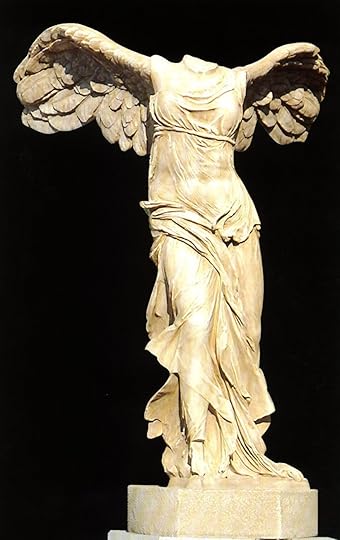
 Kalliope wrote: Yes, there is something special about the open fan (what does it suggest?) while her face and glance is turned to the side...
Kalliope wrote: Yes, there is something special about the open fan (what does it suggest?) while her face and glance is turned to the side... Great attention to details Kalliope. You must be well versed in the secret language of fans.
http://www.idealspain.com/pages/infor...
The history of the fan: http://www.victoriana.com/Fans/histor...
"The most interesting specimen of this kind is the fan which Madame de Sévigné sent to her daughter Madame de Grignan"
 To me the most interesting part of this weeks section, apart from the surprise (?¿?¿- we could see it coming - and so did the Narrator ) in the plot at the end, is the section on aesthetics. In my edition pages 483-489, and which begin when Albertine sits at the pianola.
To me the most interesting part of this weeks section, apart from the surprise (?¿?¿- we could see it coming - and so did the Narrator ) in the plot at the end, is the section on aesthetics. In my edition pages 483-489, and which begin when Albertine sits at the pianola.There are many parts that can be quoted. Here are just a couple.
Cette réaction sur la déception que causent d'abord les chefs-d'oeuvre, on peut en effet l'attribuer à un affaiblissement de l'impression initiale, où à l'effort nécessaire pour dégager la vérité.
That was exactly what was happening with the reception of Modernism...
And he now recognizes that the part in the Septet that he did not like the first time he heard it, the rhythmical part which reminded him of the bells from Combray, is now the one that he prefers...
This section made me think of Stravinsky's Rite of Spring, in which the difficult and shocking rhythms grow on you and eventually become the best parts of the piece...
 He returns to the idea that was discussed about a couple of weeks ago, and which he first mentioned in reference to Balzac, Wagner but also to the work by the historian Michelet... that it is the whole work that matters, and that a preface to the finished work would be the most interesting part coming from any of those writers..
He returns to the idea that was discussed about a couple of weeks ago, and which he first mentioned in reference to Balzac, Wagner but also to the work by the historian Michelet... that it is the whole work that matters, and that a preface to the finished work would be the most interesting part coming from any of those writers..... les grands littérateurs n'ont jamais qu'une seule oeuvre, ou plutôt réfracté à travers de milieux divers une même beauté qu'ils apportent au monde.
 And before Thomas Hardy, he mentions several of the works by Barbey d'Aurevilly. I am not familiar with this writer. But it seems he was praised by Baudelaire. He was from Normandy and he was a dandy. His dates were 1808-1889.
And before Thomas Hardy, he mentions several of the works by Barbey d'Aurevilly. I am not familiar with this writer. But it seems he was praised by Baudelaire. He was from Normandy and he was a dandy. His dates were 1808-1889.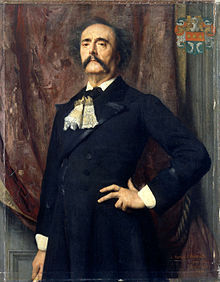
French
http://fr.wikipedia.org/wiki/Jules_Ba...
The Wiki article mentions Proust
Marcel Proust dans La Prisonnière rend hommage à l'œuvre romanesque de l'écrivain normand : la preuve du génie n'est pas dans le contenu de l'œuvre mais dans la qualité inconnue d'un monde unique révélé par l'artiste. Chez Barbey, cette qualité se manifeste par « une réalité cachée révélée par une trace matérielle » : la rougeur d'Aimée de Spens (Le Chevalier Des Touches), les us et coutumes de sa région, l'histoire orale, les nobles cités normandes, les malédictions etc. Autant de détails qui marquent l'identité et l'unité d'un artiste.
English-
http://en.wikipedia.org/wiki/Jules_Am...
 ReemK10 (Paper Pills) wrote: "Kalliope wrote: Yes, there is something special about the open fan (what does it suggest?) while her face and glance is turned to the side...
ReemK10 (Paper Pills) wrote: "Kalliope wrote: Yes, there is something special about the open fan (what does it suggest?) while her face and glance is turned to the side... Great attention to details Kalliope. You must be well..."
Haha... Reem.. no I do not know much about the language of fans... although I have several... I am more familiar with the language in paintings... and what various accoutrements can signify.
 @ Eugene: ???? .... that is somehow supposed to correlate with something I've posted? ZK937b
@ Eugene: ???? .... that is somehow supposed to correlate with something I've posted? ZK937b@ Almost everyone else: Is reading Proust nothing more than an excuse to carry-on about fluffy slippers and handbags?
 Phillida wrote: "Isn't it interesting that I can scan the comments and almost always tell, without seeing the name, who posted each one? Such individual voices."
Phillida wrote: "Isn't it interesting that I can scan the comments and almost always tell, without seeing the name, who posted each one? Such individual voices."Phillida, as you comment so rarely, it would be a pity if your very interesting remark went unanswered. And as there is very little of interest to comment on in the last few minutes, I'm glad to pick up on it.
What you say reminds me that the characters in La Recherche who speak a lot, the Duchesse, Charlus, the Duc de Guermantes, Françoise, the Narrator's mother, grandmother, Legrandin, Norpois, Mme de Villeparisis, even Morel, also have very distinctive voices. I'm quite sure that without us being told, we would almost always know who had spoken, after we had read a few of their comments, of course. They are wonderful creations.
 Since nothing of any interest whatsoever has been posted here for some considerable time, I thought I might make the observation how curious it is that our little clan has come to resemble the characters in La Recherche - we have our very own Mme Verdurin and her little band of vacuous sycophants who all agree they are such wonderful creations, even without being told!!!
Since nothing of any interest whatsoever has been posted here for some considerable time, I thought I might make the observation how curious it is that our little clan has come to resemble the characters in La Recherche - we have our very own Mme Verdurin and her little band of vacuous sycophants who all agree they are such wonderful creations, even without being told!!!Swann, Charlus ... now, who's next for expulsion ?
 Unregistered* wrote: "@ Almost everyone else: Is reading Proust nothing more than an excuse to carry-on about fluffy slippers and handbags?"
Unregistered* wrote: "@ Almost everyone else: Is reading Proust nothing more than an excuse to carry-on about fluffy slippers and handbags?"No. Ever since I had first perused the first gray tome, titled "Remembrance of Things Past," and read the first sentences, I had always wished to read this work in its entirety. There was something special about it, and I knew that, despite its length and weight, it would be a worthwhile read.
Then I saw this group and jumped in.... completing this long novel (and reading a bunch of supplemental material) has helped me fully appreciate Proust's undertaking.
 Unregistered* wrote: "Since nothing of any interest whatsoever has been posted here for some considerable time, I thought I might make the observation how curious it is that our little clan has come to resemble the char..."
Unregistered* wrote: "Since nothing of any interest whatsoever has been posted here for some considerable time, I thought I might make the observation how curious it is that our little clan has come to resemble the char..."I certainly walked into that one!
I must admit that I suspected you were joking initially but now I see that you are not. That's a pity.
 Unregistered* wrote: I thought I might make the observation how curious it is that our little clan has come to resemble the characters in La Recherche - we have our very own Mme Verdurin and her little band of vacuous sycophants who all agree they are such wonderful creations, even without being told!!!
Unregistered* wrote: I thought I might make the observation how curious it is that our little clan has come to resemble the characters in La Recherche - we have our very own Mme Verdurin and her little band of vacuous sycophants who all agree they are such wonderful creations, even without being told!!!Unregistered, you disappoint me. I wish you hadn't left this comment. There is no need for you to react like this at all. If you're unhappy reading with us, you can stop and read on your own. Insulting us because we are not to your liking is really uncalled for. I'm reading this comment of yours as your wanting to be ejected from the group. Why the drama?
 Unregistered* wrote: "Since nothing of any interest whatsoever has been posted here for some considerable time, .."
Unregistered* wrote: "Since nothing of any interest whatsoever has been posted here for some considerable time, .."Unregistered, it just looks like you expelled us.
It also seems you may not understand what you read. Neither in this forum nor in Proust.
There are very many comments in the thread about Proust's aesthetics, about the writers and historians he quoted, about composers, about war, about subjectivity, about memory, about mental associations, about immortality and the redeeming role of art, about the editor's difficult job in publishing the last volumes... etc
And may be you have not noticed that it is Proust himself who wrote often, very often (and both in the novel and in his letters) about the clothes and robes de chambre, about the fans, about style, about the blues and pinks and velvet and diamonds and "argenterie", as well as about mosaics, friezes, paintings, curtains and light effects.
In that case you probably would not be able to appreciate the books of the Italian theoretician on aesthetics Roberto Calasso, whose quotes Reem was giving us above.
May be on a next read you may get more.
 Kalliope wrote: "Unregistered* wrote: "Since nothing of any interest whatsoever has been posted here for some considerable time, .."
Kalliope wrote: "Unregistered* wrote: "Since nothing of any interest whatsoever has been posted here for some considerable time, .."Unregistered, it just looks like you expelled us.
It also seems you may not und..."
I believe Kalliope that Unregistered is referring to you as Mme Verdurin and to me as the vacuous sycophant.
 Unregistered* wrote: "@ Eugene: ???? .... that is somehow supposed to correlate with something I've posted? ZK937b
Unregistered* wrote: "@ Eugene: ???? .... that is somehow supposed to correlate with something I've posted? ZK937b@ Almost everyone else: Is reading Proust nothing more than an excuse to carry-on about fluffy slippers..."
"...I should build up my book, so to speak, like a dress rather than like a cathedral." MP
Yes, we have taken Proust's cue on describing the fashions of the period.
As long as we are in his company, we are interested in nothing else. ;)
"Mme la comtesse Greffulhe, delightfully dressed: her dress is made of pink lilac silk, trimmed with orchids, and covered with silk muslin of the same shade, her hat adorned with orchids and overlaid with lilac-coloured gauze;
Comtess de Fitz-James, black and white poplin, blue parasol, encrusted with turquoises, Louis XV jabot;
Comtess de Pourtalès, pearl-grey taffeta, sprinkled with dark flowers, pale cuffs, her hat topped with a yellow aigrette;
Marquise de Hervey de Saint-Denis, white crêpe, straw hat with white rice and white feathers, alpaca cape with grey embroidery;
Princesse de Chimay, dress of material embroidered with violets and mimosas, black hat with heliotrope bows; ...."
"A Literary Feast At Versailles" by Marcel Proust
First published in Le Gaulois, 31 May 1894.
http://www.yorktaylors.free-online.co...
PS Warning...tomorrow is Saturday.
 Phillida wrote: "Isn't it interesting that I can scan the comments and almost always tell, without seeing the name, who posted each one? Such individual voices."
Phillida wrote: "Isn't it interesting that I can scan the comments and almost always tell, without seeing the name, who posted each one? Such individual voices."Yes, we are like Françoise's "boeuf à la gelée," each adding our own flavor.
 Unregistered wrote: @ Eugene: ???? .... that is somehow supposed to correlate with something I've posted?
Unregistered wrote: @ Eugene: ???? .... that is somehow supposed to correlate with something I've posted?In the reply where I quote Proust (ML 513-514) in message 53 the Narrator has qualms about the profundity of the experience of art and a materialist hypothesis that seems to be winning. No matter the aspects, we have a difference here. And there is a difference in what I posted, before the quote, and your reply which we will call profound: "This is why such works retain meaning for us today. Great art depicts the essential unchanging truth of such relationships." and mine which is rather materialist mentioning the title of a Paul Simon album or in another message about how Proust depicts his depth of character; it's not clear to me which you replied to, but no matter.
Here I'm nuts and bolts to your what might be called your profundity, far be it from me to judge you, I'll leave that to you as you know better your ins and outs than I do. And I chose this quote in reply to express the difference between how I read Proust and how others do: you or the Tiepolo 'pinkers', etc. et al.
I read Proust in admiration, and also not, as he is not I, and embarrassingly not I, for me. I think of him as a revered teacher, I learn from him and his knowledge once in a while depresses me, like he is said to have depressed Virginia Woolf, not that I would hold a candle to her; with Mrs. Ramsey in To the Lighthouse I'm forever in love. I'm unsocial here as I ignore most of the social media aspects of this discussion group. However it provides me with a disciplined framework to read a certain number of pages a week--and I need that--primarily I make reading notes to myself (in public) as comments. Occasionally someone posts something that interests me: something I overlooked, a different way of looking at something, etc. but that's not why I'm here or for the 'warm chumminess' of it.
I'm here for Proust and I'm here for me.
 Eugene, my comment #51 was referring to your remark in #31 Among the many lovely and enriching thoughts that Proust leaves us in this passage on art and creation is this one--to say it commonly--artists are 'one trick ponies' with many variations of that trick. You give an example from this week's read, but it's exactly the same concept which Proust covered in the Vinteuil septet passage as to composers' styles. This 'one trick' to me is what constitutes style, gives an artist recognisable individuality.
Eugene, my comment #51 was referring to your remark in #31 Among the many lovely and enriching thoughts that Proust leaves us in this passage on art and creation is this one--to say it commonly--artists are 'one trick ponies' with many variations of that trick. You give an example from this week's read, but it's exactly the same concept which Proust covered in the Vinteuil septet passage as to composers' styles. This 'one trick' to me is what constitutes style, gives an artist recognisable individuality.In discussing Dostoievski we see Proust examine the dynamics of the Karamazov family, not as gewgaws, but because he can see their truths reflected in life about him in his own time, truths we also see reflected about us in life today - because these human relationships are unchanging.
Proust's "materialist hypothesis" in the context of Vinteuil's music where he was reflecting on the intangibility of music and what it evoked, in my view could be named more accurately a non-materialist hypothesis. This is not what I was referring by my phrase that the material world around us changes continually, rather I meant the anchoring of art to time by portraying specific material objects of particular epoch, such as Proust's mention of early motor vehicles, aircraft and telephones, or Vermeer's interiors.
Without your further explanation, for which I'm most grateful, it wasn't possible for me to understand the relevance of your post. Unlike you, I'm not a writer and don't regard Proust as a teacher. I see him as a mirror, showing me myself and the nature of human life. Additionally, like you I am not here for the socializing but for understanding and become impatient with the preponderance of trivializing of this great work, while at the same time finding it ironic the degree to which what he portrays of human character can be observed today around us here.
 Saturday's Fashion Pages: Special Edition
Saturday's Fashion Pages: Special EditionWhen reading Proust's visually brilliant passages for the first time, I believed he was describing an actual Fortuny dress.
Alas, Albertine's Fortuny dress is Proust's own creation.
The passages:
" It was the very evening on which Albertine had put on for the first time the indoor gown in gold and blue by Fortuny which, by reminding me of Venice, made me feel all the more strongly what I was sacrificing for her, who showed no corresponding gratitude towards me. [...]
"The Fortuny gown which Albertine was wearing that evening seemed to me the tempting phantom of that invisible Venice. It was overrun by Arab ornamentation, like Venice, like the Venetian palaces hidden like sultan's wives behind a screen of perforated stone, like the bindings in the Ambrosian Library , like the columns from which the oriental birds that symbolize alternatively life and death were repeated in the shimmering fabric, of an intense blue which, as my eyes drew nearer, turned into a malleable gold by those same transmutations which, before an advancing gondola, changed into gleaming metal the azure of the Grand Canal.
"And the sleeves were lined with a cherry pink which is so peculiarly Venetian that it is called Tiepolo pink." MP p 531
You can see Fortuny's influence on Proust in this incredible exhibit, "FORTUNY Y MADRAZO: AN ARTISTIC LEGACY" by clicking "View Slideshow:"
http://qssi.org/exhibitions-programmi...
History of Fortuny.
http://fortuny.com/History.aspx
 "...the indoor gown in gold and blue..." MP
"...the indoor gown in gold and blue..." MP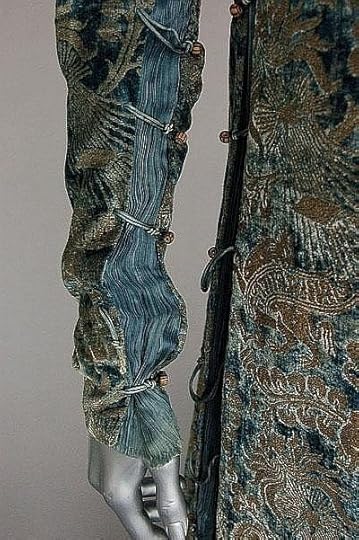
"A fine and rare Mariano Fortuny stencilled velvet gown (Tabard gown and cover) early 20th century, `labelled Mariano Fortuny, Venise', the soft blue velvet ground stenciled in gold with Medieval style patterns, the sides inset with pleated silk and laced with silk cords and fastened with Murano glass beads."
http://www.invaluable.com/auction-lot...
 "It was overrun by Arab ornamentation..." MP
"It was overrun by Arab ornamentation..." MP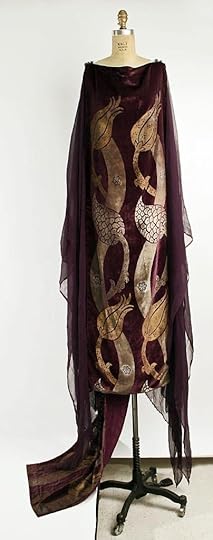
http://www.metmuseum.org/Collections/...
"The Tulip Period or Tulip Era (Ottoman Turkish: لاله دورى, Turkish: Lâle Devri) is a period in Ottoman history from the Treaty of Passarowitz on 21 July 1718 to the Patrona Halil Revolt on 28 September 1730. This was a relatively peaceful period, during which the Ottoman Empire can be said to have begun to orient itself towards Europe.
"The name of the period derives from the tulip craze among the Ottoman court society. Cultivating this culturally ambiguous emblem had become a celebrated practice.[1] The Tulip Period illustrated the conflicts brought by early modern consumer culture and was a shared material symbolism. During this period the elite and high-class society of the Ottoman Period had established an immense fondness for the tulip, which were utilized in various occasions. Tulips defined nobility and privilege, both in terms of goods and leisure time."
http://en.wikipedia.org/wiki/Tulip_pe...
Here is a PBS/Roadshow video clip describing the tulip pattern in a Fortuny wall-hanging.
http://www.pbs.org/wgbh/roadshow/arch...
 "...the oriental birds that symbolize alternatively life and death were repeated in the shimmering fabric, of an intense blue which, as my eyes drew nearer, turned into a malleable gold..." MP
"...the oriental birds that symbolize alternatively life and death were repeated in the shimmering fabric, of an intense blue which, as my eyes drew nearer, turned into a malleable gold..." MP
Textile panel detail, Mariano Fortuny; c. 1915
Gift of the Henry Morrison Flagler Museum
http://blog.fidmmuseum.org/museum/201...
 "Albertine had remained in her room, reading, in her Fortuny gown. I asked her if she would like to go with me to Versailles....“I can come as I am, we shan’t be getting out of the car.” She hesitated for a moment between two cloaks in which to conceal her indoor dress..." MP
"Albertine had remained in her room, reading, in her Fortuny gown. I asked her if she would like to go with me to Versailles....“I can come as I am, we shan’t be getting out of the car.” She hesitated for a moment between two cloaks in which to conceal her indoor dress..." MPMaybe a cloak like this?
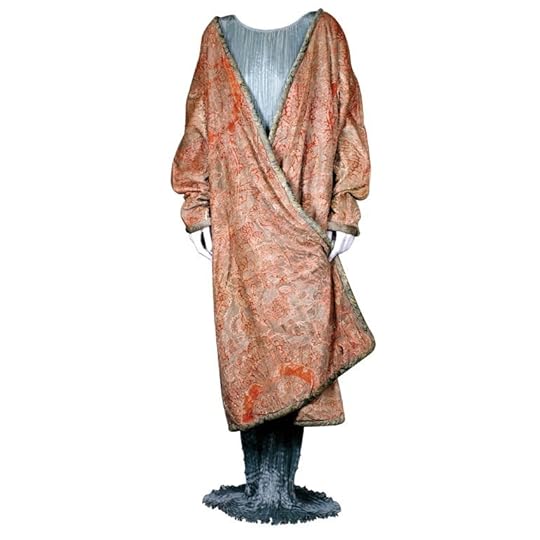
"The hand stenciling is done with real silver metallic pigments aged to a mellow, burnished color. Fortuny built his stenciled pieces layer upon layer, until he achieved the effect of antique brocade.
Pattern: Nicolo and Pomegranates"
http://www.1stdibs.com/fashion/clothi...
Or maybe this?
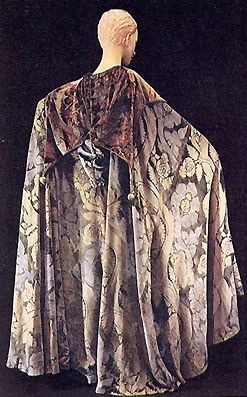
Cloak Fortuny
Source: Paola Placella Sommella, "Fashion in the work of Marcel Proust"
http://www.marcelproust.it/proust/car...
 What color is Tiepolo Pink?
What color is Tiepolo Pink? 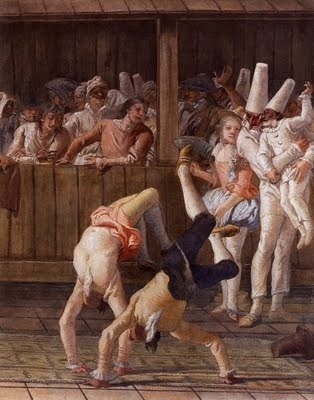
Pulcinella with Acrobats, c.1793 (fresco), Tiepolo, Giandomenico (Giovanni Domenico) (1727-1804) /
http://carezzonico.visitmuve.it/
http://www.wga.hu/html_m/t/tiepolo/gi...
"And the sleeves were lined with a cherry pink which is so peculiarly Venetian that it is called Tiepolo pink." MP
The idea, not a "cherry pink," but more muted as in the frescos.
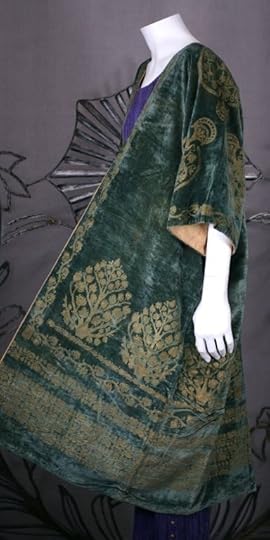
http://www.1stdibs.com/fashion/clothi...
 Unregistered* wrote: "Eugene, my comment #51 was referring to your remark in #31 Among the many lovely and enriching thoughts that Proust leaves us in this passage on art and creation is this one--to say it commonly-
Unregistered* wrote: "Eugene, my comment #51 was referring to your remark in #31 Among the many lovely and enriching thoughts that Proust leaves us in this passage on art and creation is this one--to say it commonly-"I see him as a mirror, showing me myself and the nature of human life."
Unregistered...I am glad you understand. I also "see him as a mirror, showing me myself..."
 Marcelita,
Marcelita, Thank you for the Saturday fashion pages and for keeping us close to the text.
I have several comments on these.
I agree with you that the cérise or cherry pink that Proust writes is not the one usually associated with the painter..
Here is an image from Tiepolo which captures that tonality.
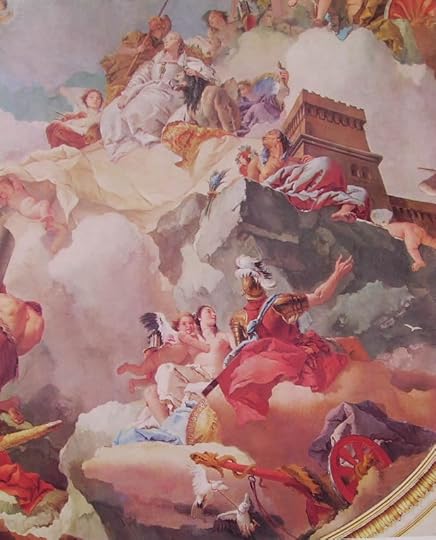
The color "rose" is so prominent in Proust, often used for the tonality of the face (joux/ cheeks), that in my audio version the reader whenever he encounters the word he usually emphasizes it prolonging the "o" in "roooooose".. It sounds wonderfully suggestive.
 Marcelita wrote: ""The hand stenciling is done with real silver metallic pigments aged to a mellow, burnished color. Fortuny built his stenciled pieces layer upon layer, until he achieved the effect of antique brocade.
Marcelita wrote: ""The hand stenciling is done with real silver metallic pigments aged to a mellow, burnished color. Fortuny built his stenciled pieces layer upon layer, until he achieved the effect of antique brocade..."
This is exactly the kind of description that Proust was requesting from Maria Hahn de Madrazo to get from Fortuny. The descriptive details.
With those Proust would be able to create his beauty in the text. It is as if the painter were requesting the tubes of paint with which he could then execute his art work.
And Proust's evocation creates the beauty that we are all enjoying and appreciating here.. keeping our eyes close to what we have in front of us rather than ranting off...
 Marcelita wrote: ""...the oriental birds that symbolize alternatively life and death were repeated in the shimmering fabric, of an intense blue which, as my eyes drew nearer, turned into a malleable gold..." MP
Marcelita wrote: ""...the oriental birds that symbolize alternatively life and death were repeated in the shimmering fabric, of an intense blue which, as my eyes drew nearer, turned into a malleable gold..." MPTex..."
Marcelita.. Wonderful that you found the birds, that were so important for Proust, in a Fortuny gown...
The overall effect reminds me of the textile named Mme de Sévigné that Reem posted earlier.
 Kalliope wrote: "To me the most interesting part of this weeks section, apart from the surprise (?¿?¿- we could see it coming - and so did the Narrator ) in the plot at the end, is the section on aesthetics. In m..."
Kalliope wrote: "To me the most interesting part of this weeks section, apart from the surprise (?¿?¿- we could see it coming - and so did the Narrator ) in the plot at the end, is the section on aesthetics. In m..."To continue with his section on aesthetics when Albertine sits at the pianola.. when he compares Dostoyevsky with Mme de Sévigné and with Elstir...
Il est arrivé que Mme de Sévigné, comme Elstir, comme Dostoïevsky, au lieu de présenter les choses dans l'ordre loguique c'est-à-dire en commencçant par la cause, nous montre d'abord l'effet, l'illusion qui nous frappe. C'est ainsi que Dostoïevsky présente ses personnages. Leurs actions nous apparaissent aussi trompeuses que ces effets d'Elstir où la mer a l'air d'être dans le ciel.
And then he continues with another of Proust's main points in his work. The difficulty in judging other people. Most of his characters always turn out to be different from the way they first appeared.
Nous sommes tout étonnés après d'apprendre que cet homme sournois est au fond excellent, ou le contraire.
Like the Verdurins, sustaining financially the ruined Saniette, without any one realizing it (except for Cottard).
 Kalliope wrote: "More comments on his own laziness and procrastination are coming up. Something which he seems to have dragged all his life and which is beginning to bother him seriously.
Kalliope wrote: "More comments on his own laziness and procrastination are coming up. Something which he seems to have dragged all his life and which is beginning to bother him seriously...était que ce défaut de..."
His procrastination and plans to lead a life with more activity, in particular is writing, from the tomorrow...
This is another ongoing theme in La recherche.
..c'était seulement parce que chaque jour j'étais sûr que le lendemain je pourrais me mettre, en même temps qu'à travailler, à me lever, à sortir, à préparer un départ pour quelque propriété que nous achèterions et où Albertine pourrait mener plus librement et sans inquiétude pour moi la vie de campagne ou de mer, de navigation ou de chasse , qui lui plairait. p. 498.
But the next day it did not happen.
 Kalliope wrote: "Kalliope wrote: "To me the most interesting part of this weeks section, apart from the surprise (?¿?¿- we could see it coming - and so did the Narrator ) in the plot at the end, is the section on ...
Kalliope wrote: "Kalliope wrote: "To me the most interesting part of this weeks section, apart from the surprise (?¿?¿- we could see it coming - and so did the Narrator ) in the plot at the end, is the section on ..."Like the Verdurins, sustaining financially the ruined Saniette, without any one realizing it (except for Cottard). "
And they didn't just take the money out of the bank, but actually gave up something, La Raspelière.
"...the exalted idea that he (M. Verdurin) himself had of his own life, or the importance that his pleasures gave him in his own eyes. This importance was further enhanced by the fact that the Verdurins were convinced that La Raspelière, which they hoped to purchase, was a property without it's match in the world." MP (Sodom and Gomorrah)
"'We the might for instance this year, instead of renting La Raspelière again, take somewhere more modest. With our income, it seems to me that to write off ten thousand francs for three years isn't out of the question.'" MP
 I was rereading the part in the introduction of the Garnier-Flammarion, written by Jean Milly, that expounds on the significance and role of the Fortuny designs in the structure of the novel.
I was rereading the part in the introduction of the Garnier-Flammarion, written by Jean Milly, that expounds on the significance and role of the Fortuny designs in the structure of the novel.Given that the whole Albertine episode was added in the second round of composition, and given also that the major failing of his Jean Santeuil, was the lack of structure, Proust was very keen on building up a cohesive work and so he needed something that would help him in pulling in this large section.
Milly's introduction, however, contains spoilers, I think for the next volume, and possibly the last one, so I will have to come back to this when we deal with Albertine disparue.
Books mentioned in this topic
Οι γάμοι του Κάδμου και της Αρμονίας (other topics)La Folie Baudelaire (other topics)
Tiepolo and the Pictorial Intelligence (other topics)
The Gothic Image: Religious Art in France of the Thirteenth Century (other topics)
Tiepolo Pink (other topics)






Son nez, sa bouche, ses yeux formaient une harmonie parfaite, isolée du reste, elle avait l'air d'un paste..."
Were you, like Proust, keeping a treasure hidden...until one is knowledgeable or curious enough to search? Found this on the right side of the web page...thank you!
There is something about this fan...the gold speckles and the way it is open on the lap, rather than folded in the hand or caught in motion.
Gustave Claude Étienne Courtois (French painter, 1859-1923) Anne Marie Dagnan 1880
http://bjws.blogspot.com/search/label...